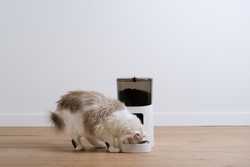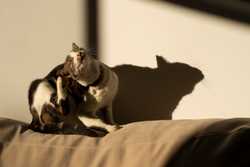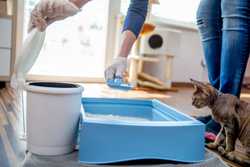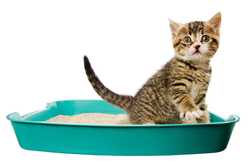- Life stage: Senior (11+ years)
- Main ingredients: Chicken broth, chicken, and pumpkin
- Guaranteed analysis: 10% crude protein (min.), 2% crude fat (min.), 1% crude fiber (max.)
The Best Wet Cat Foods for Your Pet’s Needs
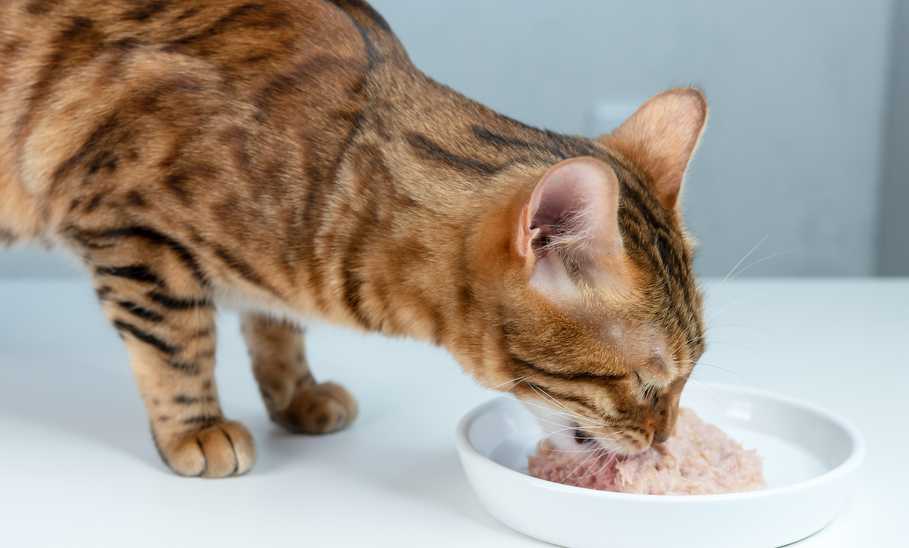
Our evaluations and opinions are not influenced by our advertising relationships, but we may earn a commission from our partners’ links. This content is created by TIME Stamped, under TIME’s direction and produced in accordance with TIME’s editorial guidelines and overseen by TIME’s editorial staff. Learn more about it.
When shopping for the best wet cat food for your cat, it’s important to consider not only factors like the ingredients in the food, but also whether that food is a good fit for your cat’s needs. With options available for different life stages, like kittens and senior cats, as well as grain-free foods and recipes designed specifically for cats with sensitive stomachs, you’ll have plenty of foods to choose from. Here are my top picks for the best wet cat foods, based on veterinary advice.
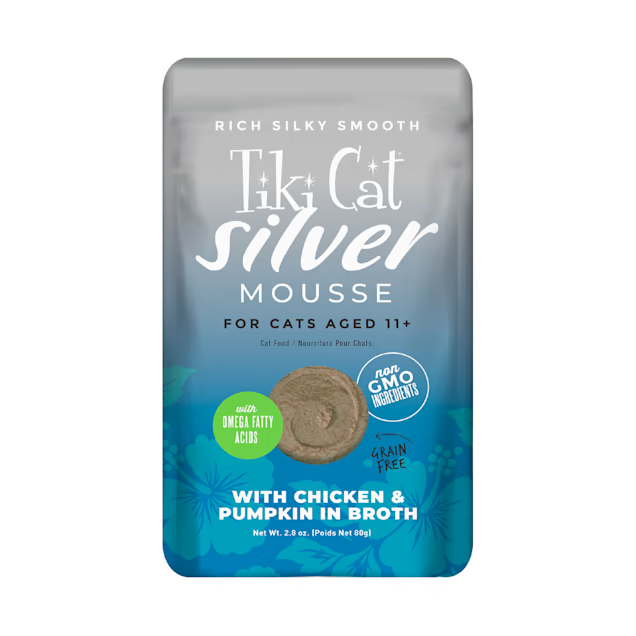
Tiki Cat Senior Mousse features a smooth texture and a broth, so it’s easier to eat for senior cats who might have dental issues. Protein comes from real chicken, while pumpkin provides fiber to support a senior cat’s slower digestion. This grain-free food contains no animal by-products or artificial colors or flavors, and it’s available in multiple flavors.
With its smooth mousse texture and protein from real meat, the Tiki Cat Senior Mousse is designed to appeal to senior cats who might have dental issues or reduced appetites.
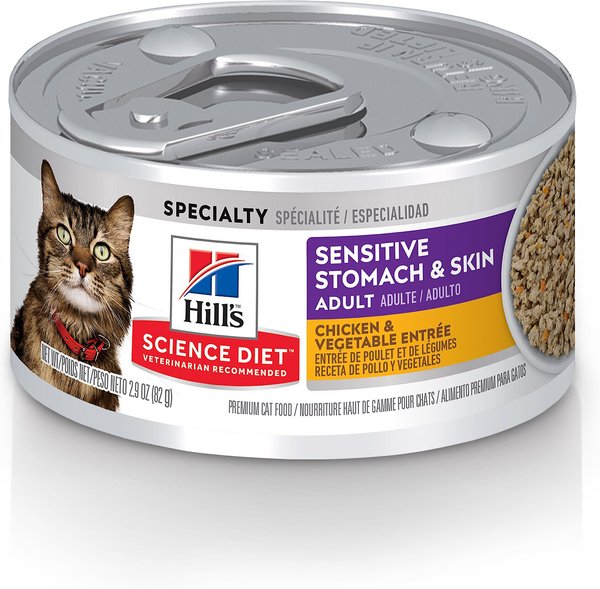
The Hill’s Science Diet Sensitive Stomach & Skin recipe features protein from quality meat sources like chicken and turkey. This recipe is grain-free, ideal for some cats with food sensitivities, and it’s designed to be easy to digest. Whole food ingredients like cranberries, fish oil, and spinach provide extra nutrients and fiber, supporting not only digestive health, but skin health, too.
Hill’s Science Diet Sensitive Stomach & Skin features whole ingredients, including chicken and turkey, that are selected to be easy for your cat to digest while also supporting your cat’s skin health.
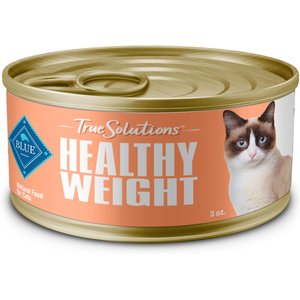
The Blue Buffalo True Solutions Healthy Weight Control is designed to help cats achieve and maintain a healthy weight. Protein comes from quality meat sources like chicken and whitefish, and each can contains just 86 calories. Whole fruits and veggies, including potatoes, carrots, cranberries, and green beans also support weight management.
With just 86 calories per can and a high fiber content to help your cat feel full, the Blue Buffalo True Solutions Healthy Weight Natural Weight Control formula may help your cat achieve and maintain an optimal weight.

The Instinct Original Grain-Free Pate features a high fat content and protein from real meats like chicken and turkey to support your cat’s weight gain. It features 131 calories per can and is available in six flavors to help keep meals appealing to your cat. While this food is full of quality ingredients, it’s also notably free of ingredients that you want to avoid, like corn, wheat, soy, and artificial colors and preservatives.
With its high protein and fat content and availability in five flavors, the Instinct Original Grain-Free Pate is designed to be highly appealing to cats and may support weight gain.

Deboned chicken is the first ingredient in the Merrick Purrfect Bistro Grain Free Chicken Recipe Pate for a high-quality protein source. The recipe features essential vitamins, minerals and taurine for balanced nutrition, but it’s free of grains. It also contains no artificial colors, flavors, or preservatives, so you’ll be feeding your cat nutritious ingredients without any add-ins.
The Merrick Purrfect Bistro Grain Free Chicken Recipe features deboned chicken as the first ingredient and contains no grains for quality nutrition.
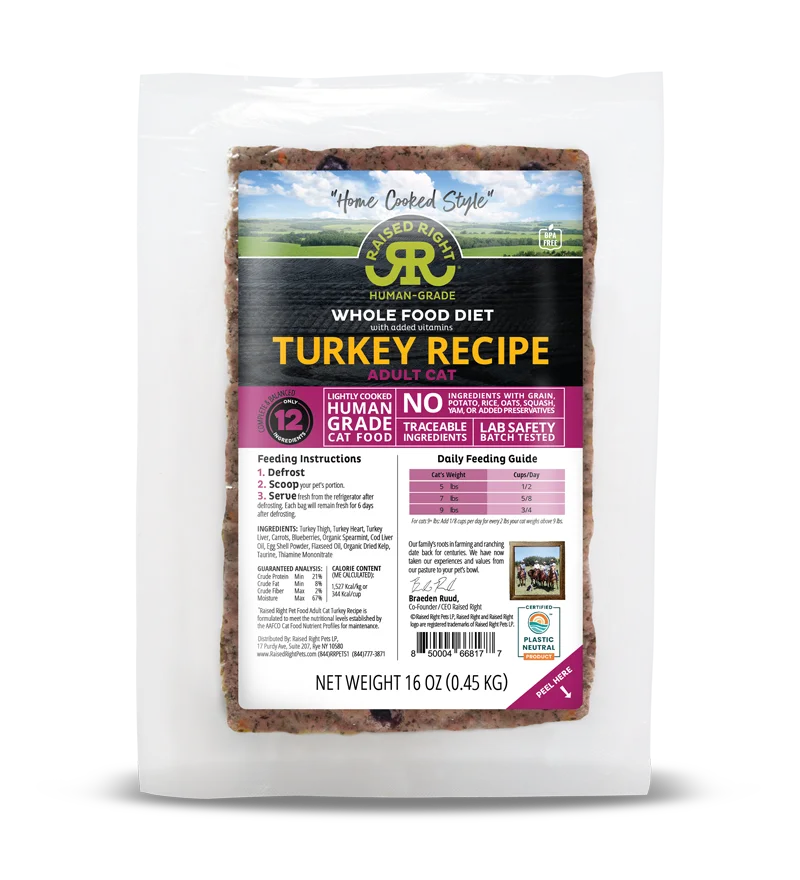
Raised Right Original Turkey Adult Cat Recipe is a low carb diet that was formulated with the help of a veterinarian.. This recipe features plenty of human-grade whole foods like blueberries, carrots, dried organic kelp and flaxseed oil. It’s lightly cooked and delivered frozen, so you can stock up on multiple packs. When you’re ready to use it, defrost the package, scoop out your cat’s portion and then refrigerate the remaining food for up to six days.
The Raised Right Original Turkey Adult Cat Recipe is crafted with human-grade whole foods and is free of grains, potato, rice, oats, squash, yam or added preservatives, so it’s a simple and natural addition to your cat’s diet.
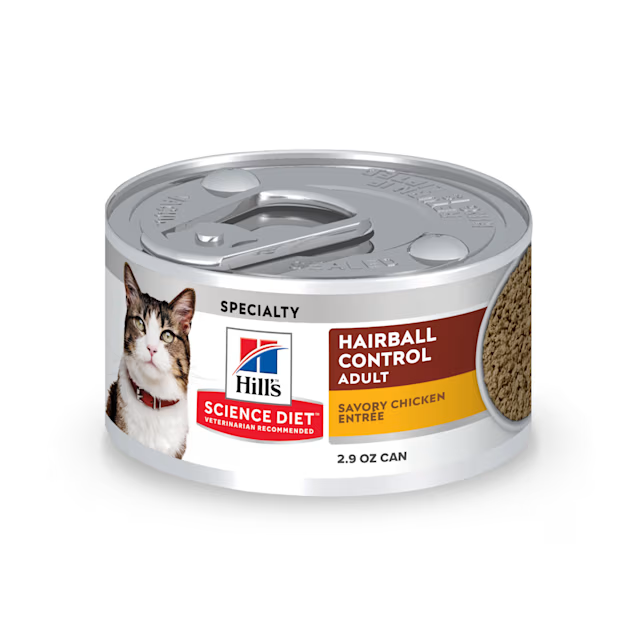
The Hill’s Science Diet Adult Hairball Control Savory Chicken Entree features plenty of fiber to help reduce hairballs. The recipe also features vitamin E and omega-3 and omega-6 fatty acids to support your cat’s skin and coat health. Real meat, including chicken and turkey, provides quality protein.
The Savory Chicken Entree includes fiber to help reduce hairballs, while vitamin E and omega fatty acids support your cat’s skin and coat health.
According to Bond Vet, wet food offers many benefits. It has a higher moisture content than dry food, which can help to keep your cat hydrated. Wet food may appeal more to picky eaters, too, so it may be a good choice for many cats. Cats with certain conditions like kidney disease and chronic constipation may also benefit from the moisture content of wet food. If you have questions about whether wet food is right for your kitty, be sure to speak with your veterinarian.
Bond Vet notes that there are pros and cons to both wet and dry food for cats. Feeding either wet or dry food, or feeding a combination of both can be a healthy and appropriate choice for your cat. When deciding which type of food is best, your cat’s age may affect your decision. Young kittens may need wet food to stay comfortable while they’re teething, and some senior cats can find wet food more appealing, which can help them to maintain a healthy weight.
In choosing the best wet cat foods, we carefully looked at the ingredients. We focused on foods with whole, quality ingredients, including protein sources, fruits, and vegetables. We chose foods with high protein content and low carbohydrates, and we also made sure to avoid foods with poor-quality ingredients like artificial fillers, preservatives or colors.
We chose brands with strong reputations for quality, and we also looked for foods that are available in multiple recipes and textures, so you can add variety into your cat’s diet or simply try out different flavors to find out what your cat likes the most.
There are many factors to consider when choosing the best wet cat foods. I asked veterinarians what you should look for when comparing foods and deciding on the one that’s right for your cat.
According to the Texas A&M College of Veterinary Medicine & Biomedical Sciences, feeding your cat a meat-only diet can cause deficiencies in vitamins, fatty acids and minerals. Feeding a complete and balanced canned food can help you ensure your cat is getting a diet that’s high in protein and low in carbohydrates, which can help meet your cat’s nutritional needs and even prevent obesity.
Some foods are currently being marketed as food toppers or complements, and these are meant to be fed in addition to a complete and balanced diet. When choosing a wet food that will be your cat’s primary diet, look for the “complete and balanced diet” distinction.
Dr. Bethany Hsia, an active mobile veterinarian and co-founder of CodaPet, explains that it’s important to look for animal-based protein sources listed as the first few ingredients, which indicates that the food contains a high percentage of those proteins. “Look for specific named meat sources like chicken, turkey, beef, or fish,” she says. “Avoid generic terms like meat by-products or animal digest, as these can be lower-quality protein sources.”
Dr. Alex Crow, a veterinary surgeon and owner of PetHealthGuru, explains that cats have a limited need for carbohydrates in their diet. “Opt for cat food with low carbohydrate content, ideally less than 10%,” he advises.
Dr. Hsia encourages cat owners to check for whole food ingredients, like fruits and vegetables. “These can provide essential vitamins and minerals to support overall health,” she explains.
“Generally, a shorter ingredient list is indicative of higher-quality cat food,” says Dr. Crow. “Stay away from products with lengthy ingredient lists or ingredients that are difficult to pronounce.”
Taurine is an amino acid that’s essential to your cat’s health, according to Lake Michigan Animal Hospital. Taurine supports metabolic processes and impacts the storage of nutrients. A taurine deficiency can lead to health issues like developmental problems, digestion issues and diarrhea, hair loss, diabetes, tooth decay, and even blindness. Look for food that includes taurine to help prevent a deficiency and support your cat’s overall health.
It’s also important to consider a brand’s reputation when choosing a food. According to Banfield Pet Hospital, a cat food product must meet certain standards to carry the Association of American Feed Control Officials (AAFCO) and U.S. Food and Drug Administration (FDA) logos. The presence of these logos on cat food certifies that the food is safe for your cat, is free of harmful substances, was produced in sanitary conditions, and is accurately labeled.
Dr. Crow explains that you may need to try out different foods to determine which wet food texture your cat most enjoys. “Cats can be picky about textures, so it might be necessary to experiment to find the one that your cat prefers,” he says. Wet cat food textures include smooth pate, chunky pieces and meat shreds, plus there are a variety of gravies and broths.
In addition to choosing a quality cat food, you’ll need to make sure that the food is appropriate for your cat’s life stage. As cats develop, their nutritional needs change. “Kittens have different nutritional needs compared to adult cats,” explains Dr. Hsia. “[If you have a kitten,] it is important to select a food that is specifically formulated for kittens.” A wet food for kittens needs to have adequate levels of essential nutrients, including high-quality protein to support the kitten’s growth and development.
In contrast, senior cats experience a slower metabolism and digestion. “Wet foods formulated for senior cats often contain lower levels of phosphorus to support kidney health, have added joint support ingredients such as glucosamine and chondroitin, and have softer textures that can be easier for senior cats to eat,” says Dr. Hsia.
Dr. Hsai explains that it’s important to avoid generic meat sources like meat by-products or animal digest, since they can be lower quality than specific meat sources like chicken or turkey. “Avoid foods that contain excessive amounts of fillers like corn, wheat, or soy. In addition, avoid artificial additives such as colors, flavors, and preservatives,” she says.
Transitioning your cat to a new food can cause some stomach upset, so it’s important to gradually make that change. CityVet recommends transitioning your cat to a new food over the course of a week. For some pets, however, a transition of two to three weeks may be needed. On days one and two, mix 25% of the new food with 75% of your cat’s old food. On days three and four, mix 50% of the new food with 50% of the old food. By days five and six, you can mix 75% of the new food with 25% of the old food. On day seven, you can fully transition your cat to eating 100% new food.
Yes, you can absolutely mix both types of foods. Bond Vet recommends that if you mix the foods, you should make sure to proportionally reduce the amount of each that you feed. For example, if you want to feed wet and dry cat foods in a 50:50 mixture, then you should only feed half as much wet and half as much dry food that is recommended for your cat’s size, age and activity level.
The information presented here is created by TIME Stamped and overseen by TIME editorial staff. To learn more, see our About Us page.
